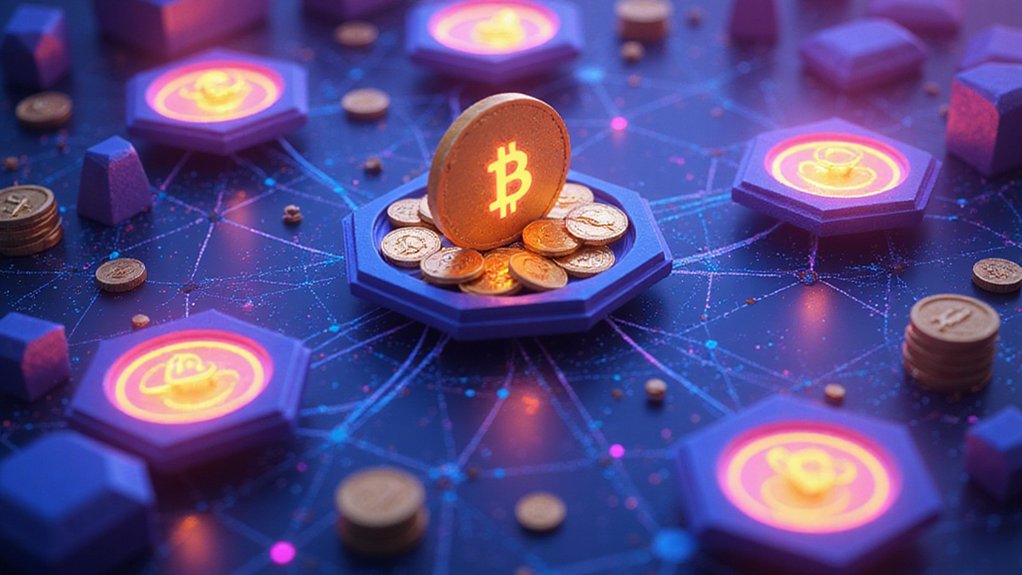Decentralized Physical Infrastructure Networks (DePIN) merge blockchain technology with physical systems, creating community-operated alternatives to centralized infrastructure. These networks—spanning storage, wireless connectivity, sensors, and energy grids—distribute ownership and decision-making among participants while automating compensation through native tokens. DePIN‘s distributed architecture delivers services at dramatically lower costs while offering enhanced security, transparency, and organic scalability. The immutable ledger guarantees accountability—a welcome departure from traditional infrastructure’s opacity and inefficiency. The financial implications of this shift are just beginning to materialize.

The decentralized revolution—having already reshaped finance through cryptocurrencies and governance through DAOs—now extends its transformative reach into physical infrastructure.
Decentralized Physical Infrastructure Networks (DePIN) merge blockchain technology with tangible, real-world systems, creating community-driven frameworks where infrastructure operation no longer requires centralized oversight.
DePIN represents the evolutionary fusion of blockchain and physical infrastructure—where community replaces corporation and participation supplants permission.
Rather than relying on monolithic corporations or government entities, these networks distribute ownership, decision-making, and rewards across participants who contribute resources to collective systems.
DePIN’s architecture spans diverse infrastructure categories—from distributed cloud storage utilizing idle computing resources, to community-powered wireless networks extending connectivity where traditional ISPs fear to tread.
Sensor networks and energy grids complete this quartet of transformation, each leveraging blockchain’s immutable ledger to track contributions, automate compensations, and eliminate the administrative bloat that traditionally plagues infrastructure projects.
The economic advantages of such systems prove compelling.
By excising intermediaries and optimizing resource allocation through market-driven incentives, DePIN frameworks frequently deliver services at fractions of their centralized counterparts’ costs. Participants are incentivized through native tokens for providing valuable resources like computational power, energy, or data to the network.
(One might reasonably ask why we’ve tolerated the alternative for so long.¹)
The security benefits—distributed architecture resistant to single-point failures and transparent governance immune to backroom machinations—only strengthen the case. These networks enhance security by providing greater resiliency through distribution across multiple independently operated nodes.
Perhaps most revolutionary is DePIN’s inherent scalability.
Where traditional infrastructure expansion requires capital-intensive central planning, these networks grow organically as participants contribute resources to meet demand, particularly in historically underserved regions where traditional ROI calculations have precluded development.
Some DePIN projects utilize specialized subnets to further enhance performance by distributing transactions across dedicated networks tailored for specific applications.
The result: infrastructure that expands precisely where needed, when needed, and at the scale needed.
The transparency inherent in blockchain-based systems further disrupts conventional infrastructure models.
Each transaction, governance decision, and resource allocation stands recorded immutably, visible to all participants.
This radical departure from the opacity of typical utility management engenders trust while simultaneously enforcing accountability—an invigorating paradigm shift in sectors long plagued by information asymmetry and consumer powerlessness.
¹ The sunk costs of legacy systems partially explain this tolerance, though institutional inertia surely bears responsibility as well.
Frequently Asked Questions
How Do Depin Tokens Maintain Value During Market Volatility?
DePIN tokens weather market tempests by anchoring value to tangible infrastructure needs—a innovative departure from crypto’s often untethered speculation.
Their real-world utility creates demand regardless of market sentiment, while investor selectivity naturally culls weaker projects during downturns.
This fundamental resilience (bolstered by integration with essential services like computing and telecom) provides a buffer against volatility that purely digital assets simply cannot match.
What Regulatory Frameworks Currently Govern Depin Projects?
DePIN projects currently navigate a regulatory patchwork rather than a cohesive framework.
They face scrutiny under securities laws (FIT21 Act), banking regulations (STABLE Act), and utility-specific restrictions.
Projects straddling physical infrastructure and blockchain must simultaneously satisfy traditional utility commissions and emerging digital asset regulations.
This regulatory ambiguity—particularly around token classification, KYC requirements, and physical components integration—remains the sector’s most significant institutional hurdle.
How Can Traditional Businesses Transition to Depin Models?
Traditional businesses can shift to decentralized infrastructure models by first evaluating which assets benefit from distributed ownership, then integrating blockchain platforms to manage contributions.
The metamorphosis requires reimagining revenue through token economics—where participants earn for resource provision—while simultaneously developing governance frameworks that empower stakeholders.
Success hinges on early community engagement and partnership with technical specialists who can navigate the inevitable regulatory hurdles that accompany such paradigm shifts.
What Security Measures Protect Physical Infrastructure in Depin Networks?
DePIN networks employ layered security protocols, including tamper-resistant hardware enclosures, cryptographic protections, and blockchain-based validation mechanisms.
Physical safeguards complement digital defenses through geofencing, biometric controls, and environmental hardening.
The architecture’s distributed nature eliminates vulnerability concentrations, while smart contracts automate protective responses to breach attempts.
Third-party audits and compliance monitoring round out a thorough approach that—remarkably—leverages decentralization itself as a security feature rather than liability.
How Do Depin Networks Handle Regional Outages or Hardware Failures?
DePIN networks tackle regional outages through distributed redundancy—their architectural ace-in-the-hole.
When hardware inevitably fails (and it will), overlapping node coverage maintains service continuity while smart contracts automatically redistribute workloads.
Token incentives motivate operators to rapidly address failures, as extended downtime hits their earnings.
This multi-pronged approach—geographic diversity, redundant systems, and economic motivation—creates a remarkably resilient infrastructure where single-point failures become mere hiccups.









